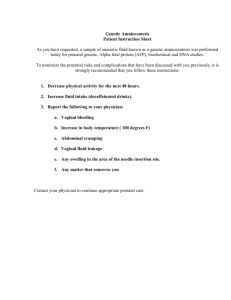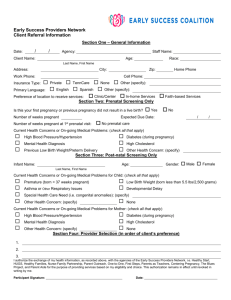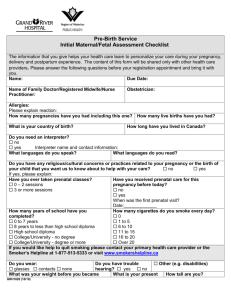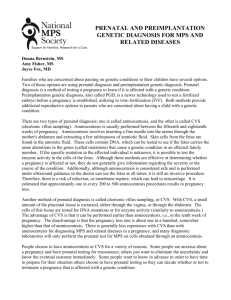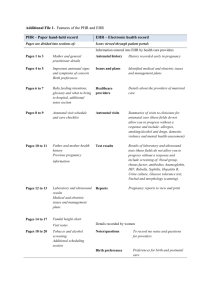Windows on tomorrow
advertisement
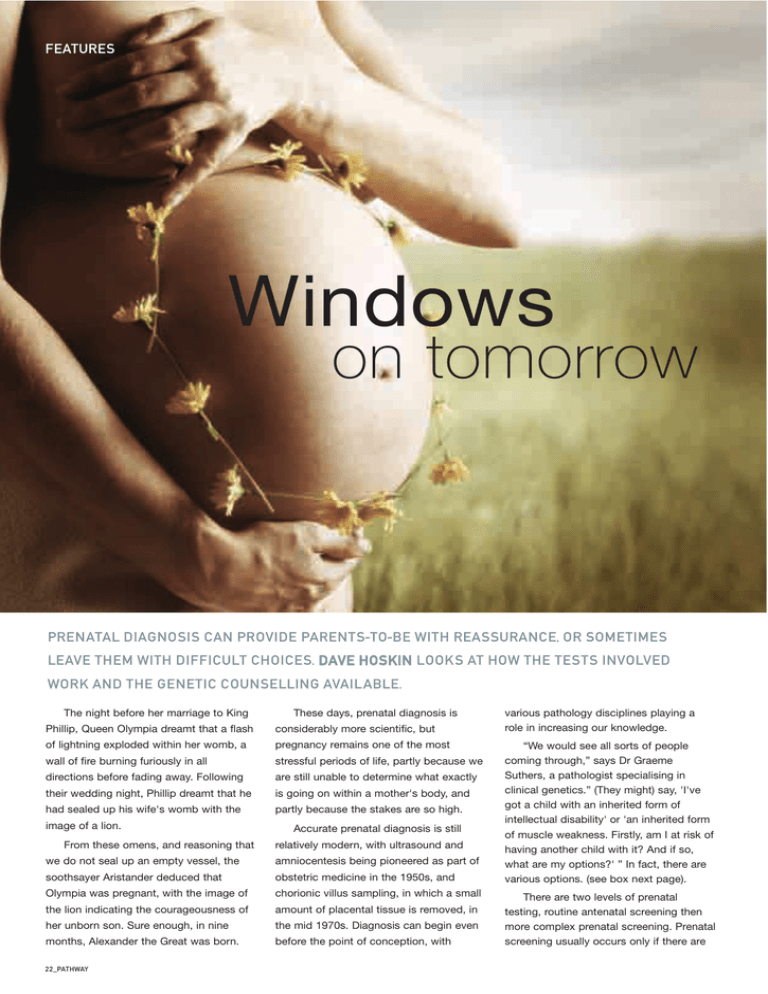
FEATURES Windows on tomorrow PRENATAL DIAGNOSIS CAN PROVIDE PARENTS-TO-BE WITH REASSURANCE, OR SOMETIMES LEAVE THEM WITH DIFFICULT CHOICES. DAVE HOSKIN LOOKS AT HOW THE TESTS INVOLVED WORK AND THE GENETIC COUNSELLING AVAILABLE. The night before her marriage to King These days, prenatal diagnosis is Phillip, Queen Olympia dreamt that a flash considerably more scientific, but of lightning exploded within her womb, a pregnancy remains one of the most wall of fire burning furiously in all stressful periods of life, partly because we directions before fading away. Following are still unable to determine what exactly their wedding night, Phillip dreamt that he is going on within a mother's body, and had sealed up his wife's womb with the partly because the stakes are so high. image of a lion. From these omens, and reasoning that Accurate prenatal diagnosis is still relatively modern, with ultrasound and we do not seal up an empty vessel, the amniocentesis being pioneered as part of soothsayer Aristander deduced that obstetric medicine in the 1950s, and Olympia was pregnant, with the image of chorionic villus sampling, in which a small the lion indicating the courageousness of amount of placental tissue is removed, in her unborn son. Sure enough, in nine the mid 1970s. Diagnosis can begin even months, Alexander the Great was born. before the point of conception, with 22_PATHWAY various pathology disciplines playing a role in increasing our knowledge. “We would see all sorts of people coming through,” says Dr Graeme Suthers, a pathologist specialising in clinical genetics.” (They might) say, 'I've got a child with an inherited form of intellectual disability' or 'an inherited form of muscle weakness. Firstly, am I at risk of having another child with it? And if so, what are my options?' ” In fact, there are various options. (see box next page). There are two levels of prenatal testing, routine antenatal screening then more complex prenatal screening. Prenatal screening usually occurs only if there are Photographer: Paul Jones Professor Lyn Gilbert, an expert in microbiology, says there are some tests that are best done before conception. concerns found in the preliminary screening of if there are other risk factors for the pregnancy from the couple's perspective or from a family history perspective. Routine Antenatal testing involves a range of tests including a urinalysis to check for sugar, protein and cells, a full blood count to make sure the women is not anaemic, (not an uncommon occurrence in pregnancy); a blood group and blood group antibody screen particularly looking at rhesus antibodies; rubella antibodies, hepatitis B virus testing , hepatitis C virus (HCV) antibodies, HIV antibodies and syphilis testing. Sometimes if indicated a urine microscopy and culture; and cervical cytology. However, Professor Lyn Gilbert, an expert in microbiology, says there are some tests that are best done before conception. “Sometimes GPs, a little bit misguidedly, order tests early in pregnancy which can be very difficult to interpret. It's much better to order them before pregnancy. The two that mainly come up are cytomegalovirus and toxoplasma.” “When blood is taken to test for the infectious agents the sample is separated into the blood cells and the serum, which is what's actually tested,” says Professor Gilbert. “That goes to a laboratory. There are specific tests for antibodies against the organisms that cause the actual infection, for example against the organisms that cause rubella and syphilis. “For hepatitis B, what we're looking for is part of the virus that causes chronic hepatitis B infection. You use either the organism that causes the disease or an extract of it as an antigen in a laboratory. You mix it with the serum and then there are various ways of labelling the combined antigen/antibody complex to show that it's there.” Gestational diabetes can occur in up to 9% of pregnancies so a Glucose Challenge test is often performed at 26 to 28 weeks. Anaemia is not an uncommon occurrence in women and pregnancy certainly increases the likelihood of the condition. It is important to be aware of haemoglobin levels so and women may be advised to increase the intake of foods high in iron such as red meat or green leafy vegetables or take an iron or folate supplement. There is considerable evidence that folate is helps protect newborns from neural tube defects, serious conditions of the brain and spine. Women should consult their doctor prior to falling pregnant to obtain further information about this. It is also very important to know the mother's blood groups prior to delivery, particularly the “rhesus factor” as interactions between the mothers and babies blood can cause major haemolytic reactions with massive destruction of the babies' blood cells, a very serious problem. Treatment is available to prevent this occurring as long as the mother's blood group is known. If routine antenatal blood screening returns a positive result, or it is felt that the pregnancy is at risk for other reasons (for instance, if the mother is aged over 35), further testing may be required. Dr Rob Lindeman, a clinical and laboratory haematologist at the Prince of Wales Hospital in Sydney who is involved in counselling prospective parent says; “Sometimes the preliminary full blood count suggests that the foetus runs a substantial risk of a particular genetic disease such as thalassaemia major (in which an affected individual has a lifelong need for blood transfusions).” Another common antenatal test is ultrasound. Working on the same basic principle as a submarine's sonar, this involves moving a hand-held scanner over the mother's abdomen, emitting sound waves and registering the echoes that come back. The echoes are converted into electrical signals and translated by a computer into a sonic picture of the foetus in real time. After the start of pregnancy, the ultrasound is one of the earliest tests available. The embryo is visible at about five and a half weeks, and the heartbeat is detectable after six. Thus certain abnormalities can be observed or warning signs collected. For instance, spina bifida can be diagnosed by seeing the baby's body. Physical symptoms of Down's syndrome can also be identified. PATHWAY_23 Antenatal Screening Routine at first antenatal visit, before 20 weeks Urinalysis; FBC; blood group, blood group antibody screen; rubella antibodies, hepatitis B virus testing (HBsAg), hepatitis C virus (HCV) antibodies, HIV antibodies and syphilis testing - serum or CSF. Urine microscopy and culture; cervical cytology. Routine at 26-28 weeks Blood group antibody screen. Glucose challenge test Routine at 30-36 weeks FBC, blood film. Group B streptococcus screening is routine in some centres. If high risk for infection Genital swab for Chlamydia trachomatis, Neisseria gonorrhoeae; HIV antibodies. The scan is routinely scheduled at 18 to 20 weeks, and although abnormalities can be missed, high percentages are discovered. For most mothers, basic prenatal testing is all that is required. Foetal abnormalities are rare, and unless the ultrasound and blood work uncover evidence of risk to the baby, there's little need for more detailed examination. For those still concerned, however, there is noninvasive screening that can be done to assess the likelihood of a chromosomal abnormality. Chemical pathologist and Medical Director of Gribbles Pathology in Adelaide Professor David Thomas says the woman's blood can be tested to determine whether she is at increased risk of having a baby with Down's syndrome. “This involves the measurement of several hormones and substances in the mother's blood. On the basis of those measurements, a risk can be calculated.” Additional tests, if appropriate “This blood test, often known as the “triple test”, identifies a number of aneuploidies. Aneuploidies usually occur where there is an extra chromosome, which happens in Down's syndrome (Trisomy 21), but there are other genetic abnormalities that can be detected using this approach, such as Trisomy 18, another major chromosomal abnormality.” Down syndrome antenatal risk testing (‘triple test’), Alpha fetoprotein - serum (neural tube defects). Experts such as Professor Thomas and Dr Lindeman “paint a picture” to help couples make a more informed decision. Photographer: Tony Lewis If the patient has recurrent genital ulcers, thought to be due to Herpes simplex infection, the diagnosis will be confirmed by virus detection. Testing enables a more informed decision as to the need for Caesarean section if lesions are still present at the onset of labour. Dr Graeme Suthers says that parents concerned about inherited genetic conditions have a range of options 24_PATHWAY They explain the nature of the disease and provide information to help parents decide whether to proceed with genetic testing. These services will involve pathologists with genetic expertise such as Dr Graeme Suthers. If the couple elects to proceed, the earliest available test, at about 10 weeks, is chorionic villus sampling (CVS). The woman lies on an examination table and a technician uses an ultrasound to observe the position of the baby and the placenta. Then, guided by the image on the ultrasound, the technician inserts a fine needle through the wall of the abdomen. Once the needle is in the placental tissue, the operator uses it to remove about 10 milligrams. The woman rests on her side for a few hours before going home, and the sample is sent to the lab. The chorionic villi, microscopic finger-like projections, are cultured and the chromosomes analysed for indicators of abnormality. Depending on the method used, the results can be available within a week, although they may take two weeks. The procedure slightly increases the risk of miscarriage - by about 1 per cent but CVS is the most popular method of invasive prenatal diagnosis. It can be done considerably earlier than amniocentesis, and the results are sufficiently reliable to enable prospective parents to make decisions. Amniocentesis is an alternative to CVS and performed at about 18 weeks. Again guided by ultrasound, a fine needle is passed through the abdominal wall and into the amniotic cavity that surrounds the foetus, gathering about three teaspoonfuls of amniotic fluid. prospect of having a child with this particular disorder is more than you can bear and you really don’t want to look at other options. You will not have any further children. The choices ost inherited genetic conditions are M rare, and therefore most GPs, if asked about them, will refer concerned couples to a genetic counsellor. Dr Graeme Suthers, who specialises in clinical genetics, would explain the alternatives to the couples along the following lines: “You have at least four options,” he begins. “One option is to say that the The fluid contains living cell samples, usually flakes of the foetus' skin, and these can be cultured in a laboratory. The cells are then tested for chromosomal abnormalities and various genetic birth defects, with biochemical and molecular biologic analysis also being performed. Amniocentesis also carries a slightly increased risk of miscarriage, estimated to be about 0.5 per cent. What amniocentesis and CVS have in common is that they are both invasive, and many mothers are understandably daunted by the prospect. However, if Professor Ian Findlay's work at Gribbles Molecular Sciences in Queensland progresses according to plan, invasive procedures may soon become a thing of the past. “Most of the women I've spoken to really want to avoid the needle through the belly, and then the two weeks wait not knowing what's happening,” Professor Findlay says. “Also, particularly in very precious pregnancies such as IVF “That egg can then be put in a small glass dish along with some sperm from the father. The egg is fertilised, and when the cells have grown into a bundle, maybe 16 or 32 cells, the laboratory scientist can “The second option is to say you accept that there is a risk of having a child with this disorder, but life is there to be lived. pluck one cell off this developing baby “The third option is to consider some form of prenatal diagnosis. There needs to be a pre-conception phase of this evaluation, where the woman comes to (the clinical geneticist) and says, ‘We have had a child with Duchenne muscular dystrophy (or something like that), and we want to know are we at high risk of having another child affected?’ Now, there’s a whole phase of investigation that needs to go on at that stage. documented that the woman is at risk of and scan for the presence or absence of disease. It’s a genetic test for one very specific condition where we’ve having a child with disease X, and disease X is the only thing that will be tested for. “The great advantage of this type of genetic diagnosis is that it is made on one cell in a test tube. The woman is not pregnant at this stage. If the developing embryo has got the abnormal gene that is causing whatever the problem is, the parents can elect not to proceed with the pregnancy at that point. From an ethical “At the end of that phase, the geneticist says to the parents, ‘Yes, you are at risk of having another child with this disorder. This is what we can offer you in terms of prenatal diagnosis.’ (One option is to consider) pre-implantation genetic diagnosis, where an egg is harvested by a gynaecologist. The woman is given a light anaesthetic; the gynaecologist makes a small incision in her abdomen, puts in a fine sucker and literally sucks an egg off the surface of her ovary. point of view, some couples find that a far pregnancies, women do not want to take any risk at all with the pregnancy. Having a simple, non-invasive test done much earlier in pregnancy is a great boon to pregnant women. contingencies they are prepared to “What we've developed and is currently undergoing clinical trials is an alternative system where we can just do a routine pap smear, just a wand into the cervix. We take that sample, we isolate the foetal cells, we DNA fingerprint the foetal cells to make sure that they really are from the foetus. We also do a genetic diagnosis to look for the sex of the foetus, single gene defects such as cystic fibrosis, and the major common abnormalities such as Down's syndrome.” this extra time will allow people to make All the medical experts agree that their role in counselling prospective parents is to provide information to enable a decision only the parents can make. Prenatal diagnosis does not commit people to a particular course, although they are urged to think seriously about what more appropriate approach than having a test later in pregnancy, where the pregnancy has indeed become established. “Option four is to consider some form of assisted reproduction using an egg or a sperm from some other person. That’s a realistic, viable option, and a fifth possibility is adoption. “There is no one right way of doing it.” contemplate before taking the tests. The hope for this procedure will be the ability to detect foetal cells from as early as six weeks. Professor Findlay hopes that the best decision possible. “Obviously one of the reasons that we're doing this is to give the parents the maximum amount of time to think about their options,” he says. “Amniocentesis (is performed) at about 18 weeks, and people wait two weeks for the results… so they're very close to the legal limit of termination; they may feel pressurised into having a termination when they haven't given it that much thought. “Whereas by doing it much earlier people can say, 'I want to find out what it really means to have a Down's syndrome child'. It gives the couples much, much more time to think about their options and make a much, much more informed choice.” PATHWAY_25
